Winter is gone, and hopefully it’s getting warmer where you live. That means it’s going to be sunny and pleasant outside, making it that much harder to resist the temptation to stay indoors and play Sega. Be strong! Don’t give into your basic urges! You can take a pill for vitamin D, and if you want fresh air, just open a window! Stay inside and try out one of the great games in this month’s Roundtable!
Miracle Warriors: Seal of the Dark Lord By Ken Horowitz
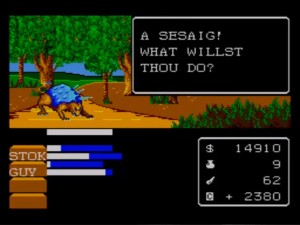 I’ve had this game for what seems like ages, but I never got around to actually playing it until now. The game’s interface kind of intimidated me, and the monsters you fight right out of the gate are quite tough. After some initial grinding, I was able to upgrade my equipment enough to risk venturing from the first town, and I must say that this isn’t a bad game. It’s not great, as the combat system is very rudimentary, and leveling is done individually (only characters who attack get experience). Despite its flaws, I had fun with Miracle Warriors and played for about eight hours straight. I still have to beat the Dark Lord herself, but that should happen over the weekend.
I’ve had this game for what seems like ages, but I never got around to actually playing it until now. The game’s interface kind of intimidated me, and the monsters you fight right out of the gate are quite tough. After some initial grinding, I was able to upgrade my equipment enough to risk venturing from the first town, and I must say that this isn’t a bad game. It’s not great, as the combat system is very rudimentary, and leveling is done individually (only characters who attack get experience). Despite its flaws, I had fun with Miracle Warriors and played for about eight hours straight. I still have to beat the Dark Lord herself, but that should happen over the weekend.
I have to say that I like Miracle Warriors. It does just enough right to be enjoyable, and I can overlook its adherence to many of the RPG tendencies of the era. I also like how the characters on the title screen look like a ’70s rock band.
Shin Megami Tensei (Sega CD) By Sebastian Sponsel
I’ve already written about the first (and only) Megaten release on a 16-bit Sega console back in January. Well, here I am, two months later, and I’m still at it. The fact that this is an untranslated Japanese RPG that I have to play with a translation guide at hand is only partly to blame. In fact, I am currently halfway through my second playthrough, trying to see how certain events play out if I make different decisions along the way. I’m usually not much of a fan of morality systems in RPGs, as they mostly come down to either being a supremely altruistic goody-two-shoes or a manic kitten-strangling serial killer, so mostly I generally play as a good guy anyway. But in this one it kind of works, because… well, it’s really hard to tell “good” and “evil” apart at times. Whereas in games like Mass Effect, the formula is something like “selfless = good” and “selfish = evil”, here the distinction is more… murky. And that’s not just because I can’t actually read the Kanji in front of me.
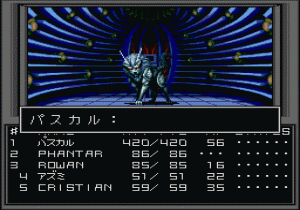 By the way, I actually tried playing the fan-translated Super Famicom version for a while, but I’ve gone and went back to playing the Mega CD port with a translation guide. Not because the translation was bad, mind you – quite the contrary – but because I kept getting lost in the original’s untextured, unmarked hallways. I may have a hard time understanding what’s going on in the Sega rendition, but at least I know where I’m actually going! Yeah, having to compare the screen to an FAQ during every dialogue sequence is a bit of a hassle, especially when you enter the more non-linear part of the game, but so what? The game’s fun, that’s the important part.
By the way, I actually tried playing the fan-translated Super Famicom version for a while, but I’ve gone and went back to playing the Mega CD port with a translation guide. Not because the translation was bad, mind you – quite the contrary – but because I kept getting lost in the original’s untextured, unmarked hallways. I may have a hard time understanding what’s going on in the Sega rendition, but at least I know where I’m actually going! Yeah, having to compare the screen to an FAQ during every dialogue sequence is a bit of a hassle, especially when you enter the more non-linear part of the game, but so what? The game’s fun, that’s the important part.
Though I do admit I’ve resorted to save scumming an emulator to get a better handle on the demon summoning mechanic and the ridiculously high encounter rate. This has sped up my gameplay way faster than any translation – guided or coded – could ever accomplish.
TMNT: The Hyperstone Heist By Vince Thornburg
I’m still a little blown away at how much Hyperstone Heist has gone up in just a few years. I remember a complete copy going for $20 not too long ago, but I guess any 8-bit/16-bit ninja turtles game is bound to spike. A friend came over to help build some shelves for a burgeoning game room, and we ended the night with beer and a playthrough of Hyperstone Heist.
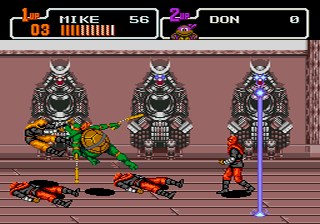 Yes this is essentially a alternate version of the more popular Turtles IV: Turtles in Time, which is every bit a classic game for the SNES, but I personally grew up on renting Hyperstone Heist more than a few times because me and my brother never managed to beat it together. Shredder would always kill him RIGHT before I got the final hit. Eventually my dad found a complete copy when it was on clearance and I’ve kept it well all these years. Truth be told, I actually hadn’t played through the damn thing in a good ten years, so this was a good night to do just that.
Yes this is essentially a alternate version of the more popular Turtles IV: Turtles in Time, which is every bit a classic game for the SNES, but I personally grew up on renting Hyperstone Heist more than a few times because me and my brother never managed to beat it together. Shredder would always kill him RIGHT before I got the final hit. Eventually my dad found a complete copy when it was on clearance and I’ve kept it well all these years. Truth be told, I actually hadn’t played through the damn thing in a good ten years, so this was a good night to do just that.
And…we beat it pretty soundly. Like, with plenty of lives to spare. I mean yeah I’m older, but this game is short. It always felt this big epic adventure during the heyday of the original show that I was obsessed with at the time. Hyperstone Heist is still absolutely a must have in your Genesis library, and is a fun beat em up for everyone, but it should start the night instead of end it.
Ecco the Dolphin (Genesis) by James Villone
During vacation in the Dominican Republic, a gift-shop item caught my eye in the display window: A cheap foam board printed with a familiar-looking dolphin jumping out of the water, and gazing intelligently at me!
“Ecco, could that really be you?” I wondered, and I dashed into the store for a closer look! Just like the Ecco games themselves, it seemed like an obscure puzzle to search through the piles of foam boards for a couple minutes, finding every print other than a dolphin, and hoping the employees wouldn’t mind my chaotic search!
 Finally I found him and yes, the picture is directly based on Boris Vallejo’s classic cover art for Ecco the Dolphin! The foam boards’ print itself is low-quality and slightly blurry, so it is hard to see clearly, but the one major difference is that Ecco is missing the stars on his forehead! Later, I learned that Vallejo’s original painting also seems to lack those stars, so the foam boards’ print could have been based on that! The print almost looks like it started as a photo of his work, which was then altered in color and details, but I actually think it is showing a new artwork, which just copied everything from the original!
Finally I found him and yes, the picture is directly based on Boris Vallejo’s classic cover art for Ecco the Dolphin! The foam boards’ print itself is low-quality and slightly blurry, so it is hard to see clearly, but the one major difference is that Ecco is missing the stars on his forehead! Later, I learned that Vallejo’s original painting also seems to lack those stars, so the foam boards’ print could have been based on that! The print almost looks like it started as a photo of his work, which was then altered in color and details, but I actually think it is showing a new artwork, which just copied everything from the original!
It is slightly mind-blowing to find these for sale in 2016, a cheap product being stamped out with a knock-off Ecco the Dolphin, twenty-three years after the game’s release! It is a testament to the beauty of that cover art, if not the video game series as well!
When I got home, I dived into my cartridge of Ecco the Dolphin, which is awesome, but is eclipsed by its Sega CD version, plus both versions of its sequel, Tides of Time! However, the original cart is probably the best-known and most iconic title of this incredible little series, based on the Genesis simulating the ocean, with tight controls over a fast-swimming dolphin, and a wild science-fiction plot-line! All the Ecco games are amazing and inspiring, with ripple-effects that can still be found today, in the most unlikely places!
Disney’s TaleSpin By Goldenband
It’s always a contentious question: what makes for a bad game? Some things we can all agree on, like unavoidable game-breaking bugs. For example, the original release of Impossible Mission II for Atari 7800 lives up to its name, with a glitch that keeps you from getting the items you need to complete the game.
Another fatal blow happens when randomness takes victory and defeat out of our hands. If you want to fill a player with murderous rage, give them a game where the only thing between them and GAME OVER is a death trap controlled by a random number generator, and getting a bad RNG means redoing hours worth of progress.
Other flaws, though, are less obvious. Take Disney’s TaleSpin: you might fire it up for the first time, play for a few minutes, and think to yourself, “OK, this isn’t that bad.” Sure, the graphics and music have that coarse mediocrity we associate with Western-developed games, and after only a few moments of gameplay it’s clear you’re in for a menu of second-rate platforming. So it’s obviously no hidden gem, but at least it’s not Fantasia or Ariel: The Little Mermaid, right?
Well, no: awful though Fantasia is, at least it’s ambitious and occasionally pretty. And though Ariel’s game is a kind of poor relation to Ecco the Dolphin, I didn’t mind playing through it at all. But TaleSpin is far more broken, cynical, and shameful than either of those games, and is an embarrassment to the proud run of Disney licenses on the Genesis.
TaleSpin’s levels are a compendium of bad design, wherein forced hits and unavoidable damage are the rule. Leaps of faith abound, and environmental hazards are often far from obvious. Enemies pounce on you from places you can’t see, and always respawn (but never de-spawn) as soon as you scroll them offscreen. Your giant hit box makes it hard to dodge attacks even when you know they’re coming, whereas many of your foes are mysteriously immune to your projectiles until they get close enough to hurt you. (The game’s hit detection can seem almost capricious: you’ll start shooting at a snake, nothing will happen for ten seconds, and then it keels over at 0:11. What changed? Who knows.)
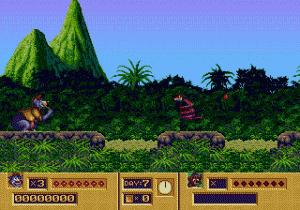 Have you ever watched a speedrun done by a player who’s completely mastered a game like Super Mario Kart, Gunstar Heroes, or Ninja Gaiden? You know how it looks like they’re almost dancing or floating through the levels — as though they’re almost weightless, and every move is a perfectly planned ballet? Well, the feeling you get from playing TaleSpin is pretty much the opposite of that: everything feels clumsy, and not the good, “I’m piloting a 30-ton robot” kind of clumsy. In this world where everything is messy and half-baked, there’s no such thing as clean gameplay.
Have you ever watched a speedrun done by a player who’s completely mastered a game like Super Mario Kart, Gunstar Heroes, or Ninja Gaiden? You know how it looks like they’re almost dancing or floating through the levels — as though they’re almost weightless, and every move is a perfectly planned ballet? Well, the feeling you get from playing TaleSpin is pretty much the opposite of that: everything feels clumsy, and not the good, “I’m piloting a 30-ton robot” kind of clumsy. In this world where everything is messy and half-baked, there’s no such thing as clean gameplay.
The worst part comes at the end of Level three, in the second boss fight against Mad Dog. This is one reason I’m adamant that, to fully understand a game, you really have to play on higher difficulty levels — since in many games, on lower difficulties you can just bulldog your way through bad design with brute force. This boss fight is no exception: fire a bunch of shots, take some sloppy damage, and you’ll clear the stage without a second thought. Someone beating TaleSpin on Easy might think “Eh, no big deal, just plow through it and you’ll be fine. It’s a forgettable game but not that bad, right?”
However, on normal or hard the battle in Level three turns ugly. Mad Dog’s shots are easily dodged once you learn the pattern and, though he’s only vulnerable right after his attack, it’s trivial to get your one shot in. But when he advances towards you and corners you at the edge of the screen, you can’t jump over him without taking major damage (at least not as Baloo; if you play as Kit you might make it, but good luck with the flying levels). Nor can you reliably run under Mad Dog when he jumps at you; his patterns aren’t consistent enough, and your hit box is just too big. By the time his health is down to the halfway point, yours is depleted.
So what to do? It turns out that the only solution is to deliberately leap into Mad Dog’s projectiles. By intentionally getting hit right as you jump over Mad Dog, you’ll have just enough invincibility to make it past him. And since his shots do less damage than touching the boss himself, you’ll have just enough health left by the end to survive.
If you’re at all tempted to think “Hey, that sounds clever!”, don’t: it’s just a kludgy hack needed to overcome a textbook case of crummy stage design. If the designers intended this, it was a stupid idea on their part; if they didn’t, then one wonders who playtested this game, since no other solution seems possible.
And that’s pretty much TaleSpin in a nutshell: the epitome of sloppy, lazy production, where a thin veneer of legitimacy (or at least mediocrity) masks a corrupt core. Sure, the game throws power-ups at you to compensate for all the forced hits, but that’s like taking someone to the hospital after you sucker-punch them. It’d be far nobler to fight fair in the first place.
After a few tries I was able to 1CC the game on hard, so “I can win it” (though not “in a minute”). So I think I’ve earned the right to say that it’s official: TaleSpin — not Fantasia, not The Little Mermaid, but TaleSpin — is the worst Disney game on the Genesis, because TaleSpin cheats the player out of the fun, fair experience they deserve.
And if you can “bear-‘n’-grin it when you’re in it,” you’re a better person than I am, because I’d like to take this game and “spin it” into oblivion.
Pat Riley Basketball By Colton Ray
I’d heard a lot of bad things about this game, but I recently won a complete copy on eBay for cheap and decided to check it out. While I don’t think it’s the travesty a lot of people proclaim, the game does have some very serious flaws that hinder the fun.
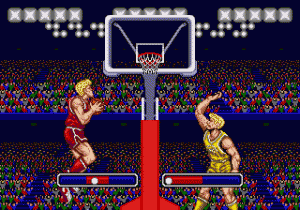 All the players have butter fingers; it’s ridiculously easy to steal the ball from the opposing side, and vice versa. So, most of the game is spent watching the other team rip the ball from your hands or intercepting your passes. When I did get the ball, at least 60% of my shots were called for traveling, due to the shoddy controls. Needless to say, I ended up getting my behind handed to me by the other team. No NBA license by the way, just a few different cities with different color jerseys. The music is actually very nice and the graphics don’t look half-bad (the cut scenes are ambitious but just look very cheesy.) Unfortunately, the gameplay begins to grind on the nerves after a while. I ended up not having too much fun. At least we eventually got the NBA Live series to make up for this misfire.
All the players have butter fingers; it’s ridiculously easy to steal the ball from the opposing side, and vice versa. So, most of the game is spent watching the other team rip the ball from your hands or intercepting your passes. When I did get the ball, at least 60% of my shots were called for traveling, due to the shoddy controls. Needless to say, I ended up getting my behind handed to me by the other team. No NBA license by the way, just a few different cities with different color jerseys. The music is actually very nice and the graphics don’t look half-bad (the cut scenes are ambitious but just look very cheesy.) Unfortunately, the gameplay begins to grind on the nerves after a while. I ended up not having too much fun. At least we eventually got the NBA Live series to make up for this misfire.

Recent Comments